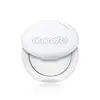What's inside
What's inside
 Key Ingredients
Key Ingredients

 Benefits
Benefits

 Concerns
Concerns

 Ingredients Side-by-side
Ingredients Side-by-side

Talc
AbrasiveSilica
AbrasiveMagnesium Myristate
Octyldodecyl Stearoyl Stearate
EmollientPolymethylsilsesquioxane
Mica
Cosmetic Colorant1,2-Hexanediol
Skin ConditioningDimethicone
EmollientTriethoxycaprylylsilane
Parfum
MaskingAlpha-Isomethyl Ionone
PerfumingBenzyl Benzoate
AntimicrobialBenzyl Salicylate
PerfumingCoumarin
PerfumingGeraniol
PerfumingHydroxycitronellal
PerfumingLimonene
PerfumingLinalool
PerfumingCI 77492
Cosmetic ColorantCI 77499
Cosmetic ColorantMethicone
EmollientVinyl Dimethicone/Methicone Silsesquioxane Crosspolymer
Water
Skin ConditioningButylene Glycol
HumectantChrysanthemum Morifolium Flower Extract
Skin ConditioningLilium Candidum Flower Extract
Skin ConditioningTalc, Silica, Magnesium Myristate, Octyldodecyl Stearoyl Stearate, Polymethylsilsesquioxane, Mica, 1,2-Hexanediol, Dimethicone, Triethoxycaprylylsilane, Parfum, Alpha-Isomethyl Ionone, Benzyl Benzoate, Benzyl Salicylate, Coumarin, Geraniol, Hydroxycitronellal, Limonene, Linalool, CI 77492, CI 77499, Methicone, Vinyl Dimethicone/Methicone Silsesquioxane Crosspolymer, Water, Butylene Glycol, Chrysanthemum Morifolium Flower Extract, Lilium Candidum Flower Extract
Mica
Cosmetic ColorantSynthetic Fluorphlogopite
Magnesium Myristate
Polymethyl Methacrylate
Silica
AbrasiveTapioca Starch
Lauroyl Lysine
Skin ConditioningSaccharomyces Ferment
Skin ConditioningOctyldodecyl Stearoyl Stearate
EmollientBoron Nitride
AbsorbentDiisostearyl Malate
EmollientSqualane
EmollientWater
Skin Conditioning1,2-Hexanediol
Skin ConditioningCaprylyl Glycol
EmollientStearoyl Glutamic Acid
CleansingPolymethylsilsesquioxane
Iron Oxides
Mica, Synthetic Fluorphlogopite, Magnesium Myristate, Polymethyl Methacrylate, Silica, Tapioca Starch, Lauroyl Lysine, Saccharomyces Ferment, Octyldodecyl Stearoyl Stearate, Boron Nitride, Diisostearyl Malate, Squalane, Water, 1,2-Hexanediol, Caprylyl Glycol, Stearoyl Glutamic Acid, Polymethylsilsesquioxane, Iron Oxides
 Reviews
Reviews

Ingredients Explained
These ingredients are found in both products.
Ingredients higher up in an ingredient list are typically present in a larger amount.
1,2-Hexanediol is a synthetic liquid and another multi-functional powerhouse.
It is a:
- Humectant, drawing moisture into the skin
- Emollient, helping to soften skin
- Solvent, dispersing and stabilizing formulas
- Preservative booster, enhancing the antimicrobial activity of other preservatives
We don't have a description for Magnesium Myristate yet.
Mica is a naturally occurring mineral used to add shimmer and color in cosmetics. It can also help improve the texture of a product or give it an opaque, white/silver color.
Serecite is the name for very fine but ragged grains of mica.
This ingredient is often coated with metal oxides like titanium dioxide. Trace amounts of heavy metals may be found in mica, but these metals are not harmful in our personal products.
Mica has been used since prehistoric times throughout the world. Ancient Egyptian, Indian, Greek, Roman, Aztec, and Chinese civilizations have used mica.
Learn more about MicaOctyldodecyl Stearoyl Stearate is created from stearic acid.
It is an emollient and thickens the lipid (oil) portion of a product. Due to its emollient properties, it may not be fungal-acne safe.
Polymethylsilsesquioxane is a silicone used as a film forming agent.
When applied to the skin, this ingredient creates an invisible film on the surface. This film still allows oxygen to pass through, but prevents moisture from escaping. This can help condition and hydrate the skin. It also leaves a silky feel when applied.
Polymethylsilsesquioxane has not been shown to clog pores. It has been deemed safe to use up to 55%, but most cosmetics use much less.
If you have concerns about using this ingredient, we recommend speaking with a professional.
Learn more about PolymethylsilsesquioxaneSilica, also known as silicon dioxide, is a naturally occurring mineral. It is used as a fine, spherical, and porous powder in cosmetics.
Though it has exfoliant properties, the function of silica varies depending on the product.
The unique structure of silica enhances the spreadability and adds smoothness, making it a great texture enhancer.
It is also used as an active carrier, emulsifier, and mattifier due to its ability to absorb excess oil.
In some products, tiny microneedles called spicules are made from silica or hydrolyzed sponge. When you rub them in, they lightly polish away dead skin layers and enhance the penetration of active ingredients.
Learn more about SilicaWater. It's the most common cosmetic ingredient of all. You'll usually see it at the top of ingredient lists, meaning that it makes up the largest part of the product.
So why is it so popular? Water most often acts as a solvent - this means that it helps dissolve other ingredients into the formulation.
You'll also recognize water as that liquid we all need to stay alive. If you see this, drink a glass of water. Stay hydrated!
Learn more about Water